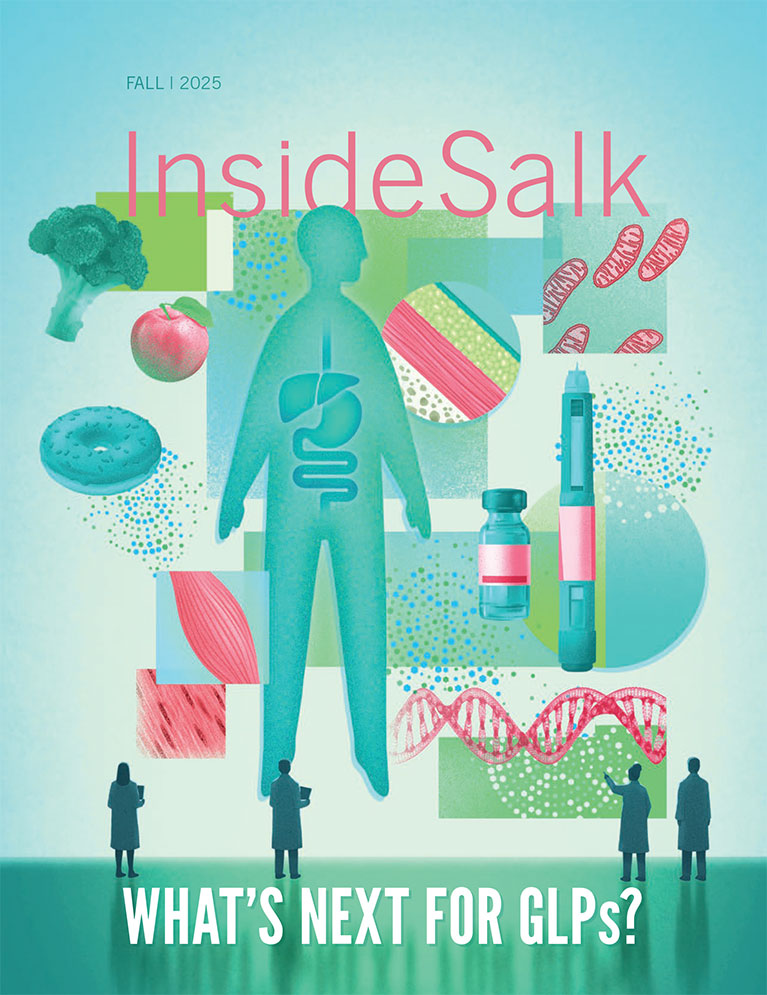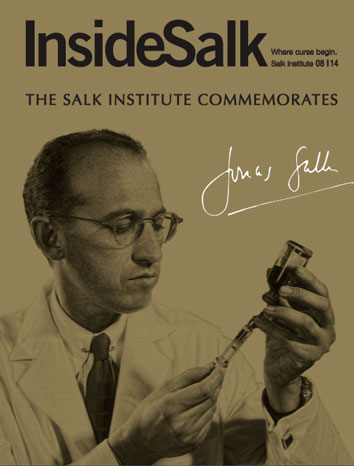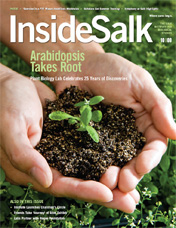In an attempt to provide a more objective scale for research and diagnosis, Terrence Sejnowski, first author David Peterson and colleagues have developed a computer program that takes over the job, analyzing videos of patients’ faces. The program could eventually be expanded to help study facial tics and twitches in other contexts, including Tourette syndrome, schizophrenia and Parkinson’s disease. The research was described online on October 21, 2016, in Neurology, the medical journal of the American Academy of Neurology.
Read News ReleaseDiscoveries
Heart disease, leukemia linked to dysfunction in nucleus
We put things into a container to keep them organized and safe. In cells, the nucleus has a similar role: keeping DNA protected and intact within an enveloping membrane. But a new study by the lab of Martin Hetzer, detailed in the November 2, 2016, issue of Genes & Development, reveals that this cellular container acts on its contents to influence gene expression. Using a suite of molecular biology technologies, Hetzer, first author Arkaitz Ibarra and colleagues discovered that two proteins, which sit in the nuclear envelope, together with the membrane- spanning complexes they form, actively associate with stretches of DNA to trigger expression of key genes. Better understanding these higher-level functions could provide insight into diseases that appear to be related to dysfunctional nuclear membrane components, such as leukemia, heart disease and aging disorders.
Read News Release“Princess Leia” brainwaves help sleeping brain store memories
Gene-editing technology partially restores vision in blind animals
Along with Professor Juan Carlos Izpisua Belmonte, first authors Jun Wu, Reyna Hernandez-Benitez, Keiichiro Suzuki and colleagues discovered the ability to, for the first time, insert DNA at a target location into the nondividing cells that make up the majority of adult organs and tissues. The technique, which the team showed was able to partially restore visual responses in blind rodents, will open new avenues for basic research and a variety of treatments, such as for retinal, heart and neurological diseases.
Immune receptors amplify “invader” signals by turning into mini-machines
When a receptor on the surface of a T cell—a sentry of the human immune system—senses a single particle from a harmful intruder, it immediately kicks the cell into action, launching a larger immune response. But exactly how the signal from a single receptor, among thousands on each T cell, can be amplified to affect a whole cell has puzzled immunologists for decades. Salk Associate Professor Björn Lillemeier, first author Zachary Katz and colleagues discovered the key to the amplification of an “invader” signal: the T cell receptor that detects the intruder turns into a mini-machine, activating and releasing copy after copy of a protein called ZAP70. The finding, published in Nature Immunology on November 21, 2016, could help scientists design better immune-mediated treatments for cancer or autoimmune diseases.
Read News ReleaseCollaboration uncovers how molecular machines assemble
Ribosomes—macromolecular machines consisting of RNA and proteins that twist, fold and turn—are responsible for making all of the protein within a cell, but because they assemble so speedily, researchers haven’t been able to figure out how they come together. As part of a collaboration between Salk and The Scripps Research Institute, co-senior author Dmitry Lyumkis, a Helmsley-Salk Fellow, deployed a cutting-edge imaging method called single-particle cryo-electron microscopy (cryo-EM) and accompanying analysis tools to decipher some of the key steps for how ribosomes are assembled, a first step in understanding their roles in health and disease. The results appeared online December 1, 2016, in the journal Cell.
Read News ReleaseSmall but mighty: tiny proteins with big roles in biology
We all know how hard it is to find something small like a dropped contact lens that blends into the background. It’s similarly tough for biologists to find tiny proteins against the complex background of the cell. But, increasingly, scientists are learning that such micro- proteins, which are overlooked by traditional detection methods, also have important biological roles to play. Using a new microprotein detection strategy, Salk Professor Alan Saghatelian, research associate Jiao Ma and collaborators discovered a human microprotein involved in one of the cell’s key housekeeping tasks: clearing out genetic material that’s no longer needed. The new molecule, dubbed NoBody, could provide a better understanding of how the levels of genes, including disease genes, are controlled in the cell. The paper appears in the December 5, 2016, issue of Nature Chemical Biology.
Read News ReleaseThe Goldilocks effect in aging research
Ever since researchers connected the shortening of telomeres— the protective caps on the ends of chromosomes—to aging and disease, the race has been on to understand the factors that govern telomere length. Salk Professor and holder of the Donald and Darlene Shiley Chair Jan Karlseder, first author Teresa Rivera and colleagues have found that a balance of elongation and trimming in stem cells results in telomeres that are, as Goldilocks would say, not too short and not too long, but just right. The finding deepens our understanding of stem cell biology and could help advance stem cell based therapies, especially related to aging and regenerative medicine.
See microscopy from this research.
Read News ReleaseFeed a cold, starve a fever?
Turning back time: Salk scientists reverse signs of aging
Salk Professor Juan Carlos Izpisua Belmonte, along with first authors Alejandro Ocampo, Paloma Martinez-Redondo, Pradeep Reddy and colleagues, found that intermittent expression of genes normally associated with an embryonic state can reverse the hallmarks of old age. Their approach, which not only prompted human skin cells in a dish to look and behave young again, also resulted in the rejuvenation of mice with a premature aging disease, countering signs of aging and increasing the animals’ lifespan by 30 percent. The early-stage work provides insight both into the cellular drivers of aging as well as possible therapeutic approaches for improving human health and longevity. The Salk researchers believe that induction of epigenetic changes via chemicals or small molecules may be the most promising approach to achieve rejuvenation in humans.
Building a better brain
When you build models, whether ships or cars, you want them to be as much like the real deal as possible. This quality is even more crucial for building model organs, because disease treatments developed from these models have to be safe and effective for humans. Salk Professor Joseph Ecker, first author Chongyuan Luo and European collaborators have studied a 3D “mini-brain” grown from human stem cells and found it to be structurally and functionally more similar to real brains than the 2D models in widespread use. The discovery, appearing in the December 20, 2016, issue of Cell Reports, indicates that the new model could better help scientists understand brain development as well as neurological diseases like Alzheimer’s or schizophrenia.
Read News ReleaseSalk scientists crack the structure of HIV machinery
Helmsley-Salk Fellow and senior author Dmitry Lyumkis, first author Dario Passos and collaborators have solved the atomic structure of a key piece of machinery that allows HIV to integrate into human host DNA and replicate in the body. The findings about this machinery, known as the “intasome,” appeared January 6, 2017, in Science and yield structural clues informing the development of new HIV drugs.
Read News ReleaseWorms have teenage ambivalence, too
Work by Sreekanth Chalasani’s lab suggests that, in both roundworms and humans, adolescent brains mature to stable adult brains by changing which brain cells they use to generate behavior. Teen worm brains drive wishy-washy behavior that allows them to stay flexible in an uncertain world, while adult worm brains drive efficient behavior. The discovery, published online in eNeuro in January by Chalasani, first author Laura Hale and colleagues, provides insight into the underlying drivers of neurological development that could help better understand the human brain and disease.
Curb your immune enthusiasm
Normally when we think of viruses, from the common cold to HIV, we want to boost people’s immunity to fight them. But for scientists who develop therapeutic viruses (to, for example, target cancer cells or correct gene deficiencies) a more important question is: How do we keep people’s natural immune responses at bay? In these cases, an overenthusiastic immune response actually undermines the therapy. Salk Associate Professor Axel Nimmerjahn and first author Yusuf Tufail—along with Associate Professor Clodagh O’Shea, Professor Greg Lemke and colleagues— discovered that inhibiting a protein called phospholipid scramblase 1 (PLSCR1) controls the infected cell’s antiviral response and provides long-term protection from immune attack and excessive inflammation. The results, described in the January 19, 2017, issue of Neuron, hold promise both for virally delivered treatments and inflammatory conditions like infections, autoimmune disorders such as lupus, or neurodegenerative diseases such as Alzheimer’s.
Findings highlight promise of chimeric organisms for science and medicine
The word “chimera” originally described mythological creatures or deities in polytheistic religions. In science, an interspecies chimera is an organism containing cells from different species. Rapid advances in the ability to grow cells, tissues and organs of one species within an organism of another species (forming “chimeric” organisms) offer an unprecedented opportunity for tackling longstanding scientific mysteries and addressing pressing human health problems, particularly the need for transplantable organs and tissues. The lab of Juan Carlos Izpisua Belmonte combined cutting-edge gene-editing and stem cell technologies to grow a rat pancreas, heart and eyes in a developing mouse, providing proof-of-concept that functional organs from one species can be grown in another. The work marks the first steps toward the generation of transplantable human organs using large animals.
Featured Stories
 A Masterful DesignMaintaining the Salk Institute’s iconic architectural vision.
A Masterful DesignMaintaining the Salk Institute’s iconic architectural vision. Inside the Mind of Ted WaittWhether it’s vital funding, imaginative technology or the perspective of a successful CEO, new Board Chair Ted Waitt says adding a little magic in the right place enables great discoveries.
Inside the Mind of Ted WaittWhether it’s vital funding, imaginative technology or the perspective of a successful CEO, new Board Chair Ted Waitt says adding a little magic in the right place enables great discoveries. Surviving SuperbugsWe’re losing the war with infectious diseases. Ending the arms race with infectious diseases could mean learning to live with them.
Surviving SuperbugsWe’re losing the war with infectious diseases. Ending the arms race with infectious diseases could mean learning to live with them.




















































